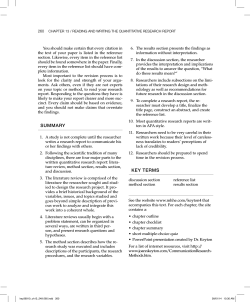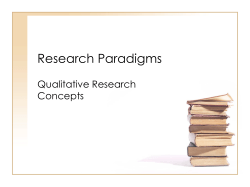
Writing A Research Proposal Title Abstract This should be short, sharp, and describe what your research is about: it may also be a
Writing A Research Proposal Title This should be short, sharp, and describe what your research is about: it may also be a ‘working title’ that you will revise as your project develops. Abstract Write a 200250 word summary of the proposed research, including the key points: what, why, how and when. Include a brief description of the aims of the study, the research population or subject matter, the methods to be used and the time frame. Indicate also why this research is needed, and its uses. [This will, of course, be the last thing you write.] Aims & Objectives This section answers the question why this research is being done. Outline the aims and objectives of the research, and/or the research questions. Define any specialised terms you may use and indicate why the aims and objectives are appropriate. Timespan Prepare a brief breakdown of how long the study is expected to take, and its various stages. Consider such items as Any further planning and approvals Ethical approval Literature search and review Pretests or pilot trials Collection of data Analysis/synthesis of data Writingup: including drafts and revisions You may also wish to indicate further stages such as dissemination of information, participation in policy formation, etc. Background There are two aspects to this ¾ one is how the project came about, and the other is its relationship to other research in the field. 1. Who is undertaking this research and for whom (where applicable)? Why choose this topic? Who is going to gain from this research? 2. Write a brief history of the research question, indicating other work in the field and a summary of previous conclusions. Include a brief literature review indicating where you gained your information and any personal references such as discussions with people, conference papers, policy documents, memos, etc. This section sets your proposal within the wider context. Research Design This section sets out the theoretical concepts that have been chosen from the literature review as the basis for developing and carrying out the project. It answers the question, ‘why is it being done in this particular way?’ Indicate the general steps of the project and justify them using the literature to argue for the appropriateness of the particular methods you have chosen. You may also wish to briefly describe the ideal approach and why you have chosen to deviate from this. Methodology This is where you set out the details of the specific methodologies and techniques you will use. Consider the following: How is the study to be done? What are your sources of data? What data will be collected? What kinds of methods, procedures and instruments will be used for data collection? Who is included (excluded) from your research population or sample and why? How to you intend to ensure reliability and validity? In what contexts will your results be interpreted and understood? The Methodology section is not a repetition of the Design section. The latter gives a broad overview, while the former deals with the practical specifics, of what, how, who, and where. Significance This is where you state the anticipated outcomes of the project in relation to theory, practice, social policy, and personal learning. Costing Estimate the actual costs to you for doing the research, such as Photocopying Library searches and interloans Stationery and psotage Tapes Transport Reproduction and binding of your thesis Bibliography List all the books, journal articles, reports, Acts, memos and submissions that you have referred to in your proposal, in alphabetical order. Ethical Statement Students undertaking any form of postgraduate research using animals or people have to submit a proposal to either the animal ethics committee or the human ethics committee for approval before the data gathering can begin. You must ensure that the project’s focus and methodology conform to the ethical code of your discipline and that they are not likely to bring, you, the School or university into disrepute. Your supervisor or the School postgraduate coordinator will be able to advise you on this process. NB: if you make subsequent modifications to your research design that have ethical implications, you will need to submit a new ethical statement to the appropriate ethics committee. CRITERIA FOR ASSESSING A RESEARCH PROJECT OR THESIS 1. Is the research topic, question or intention clear? 2. What is the extent of the researcher’s statement about their involvement in the project? 3. What is the scope of the literature review? 4. How is the literature review related to: a. The research topic? b. The research methods? c. The research data? d. The research outcome/recommendations/conclusion? 5. What research methods are used? 6. What different research methods are used? 7. How are the research methods handles? 8. How appropriate are the research methods to the research topic? 9. How does the researcher demonstrate an awareness of the limitations of the research methods? 10. What is the relationship between the research methods used and the format of the report? 11. How is the information gathered/organised in the report? 12. What is the relationship between presenting the raw data, unedited texts, the people’s voices and the researcher’s interpretations? 13. What are the main themes addressed in the report? 14. What is the basis for any interpretations? a. What is the relationship between the philosophical/theoretical basis and the interpretations? b. How do the interpretations clarify the data? 15. What new information or ways of looking at the topic does the researcher present? 16. For which audience was this report written? 17. What implications/recommendations/conclusions are drawn from the research? 18. How consistent are the implications with a. The research question? b. The philosophy underpinning the research? c. The methods to collect the data? 19. What are the practical and policy implications described? 20. How does the researcher demonstrate an awareness of the political implications and power relationships surrounding to project? 21. How does the project read/present? a. How are the contents, references, tables, diagrams, presented? b. What is contained in the appendices and bibliography? 22. What is the overall impression of the research report? 23. Does the researcher identify related areas that are not included in the research report? 24. What are the reasons for not including those areas? 25. What has the researcher learnt from being involved in this research process? GUIDELINES FOR EVALUATING EMPIRICAL/EXPERIMENTAL STUDIES A. PROBLEM 1. Is the problem clearly stated? 2. Is the problem significant ¾ will the results contribute to the solution of some practical or theoretical problem? 3. Is the relationship to previous research made clear? B. DESIGN 4. Are the assumptions of the study clearly stated? 5. Are the limitations of the study clearly stated? 6. Are important terms in the study defined? 7. Is the research design fully described? 8. Is the research design appropriate? 9. Are the population and sample described? 10. Is the method of sampling appropriate? C. PROCEDURE 11. Are the datagathering methods described? 12. Are the datagathering methods appropriate? 13. Are the validity and reliability of the evidence established? D. ANALYSIS 14. Are the analysis methods appropriate and are they properly applied? 15. Are the results of the analysis clearly presented? E. CONCLUSIONS 16. Are the conclusions clearly stated? 17. Does the evidence substantiate the conclusions? 18. Are the generalisations confined to the population from which the sample was drawn? 19. Is the report logically and clearly written?
© Copyright 2025





















